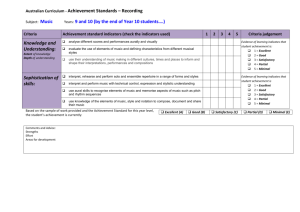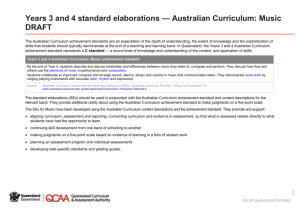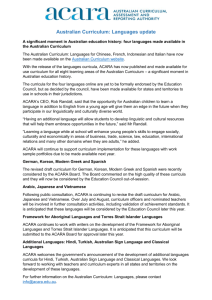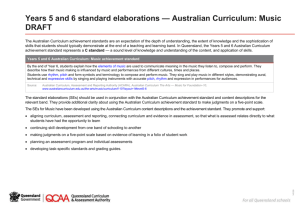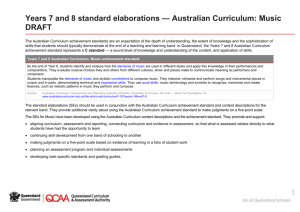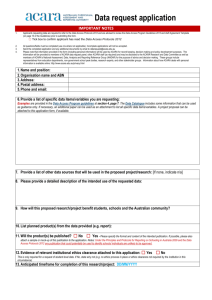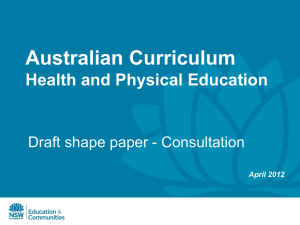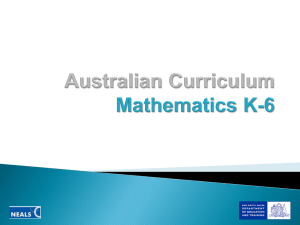Years 9 and 10 standard elaborations * Australian Curriculum
advertisement
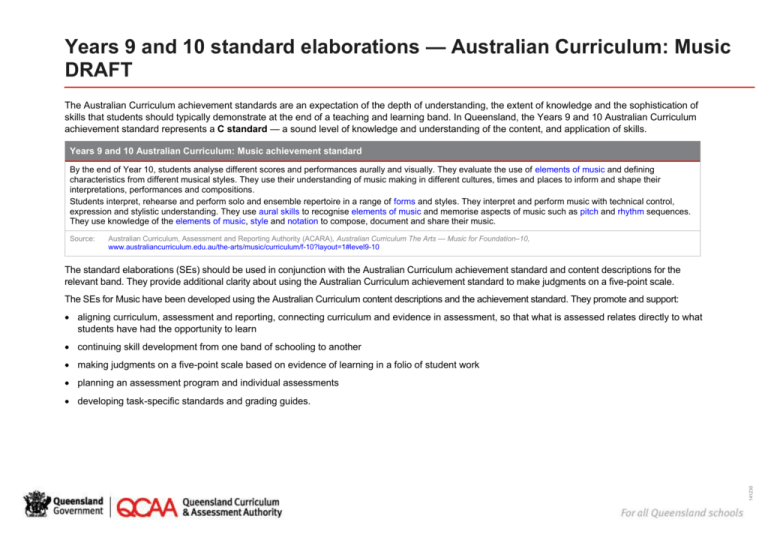
Years 9 and 10 standard elaborations — Australian Curriculum: Music DRAFT The Australian Curriculum achievement standards are an expectation of the depth of understanding, the extent of knowledge and the sophistication of skills that students should typically demonstrate at the end of a teaching and learning band. In Queensland, the Years 9 and 10 Australian Curriculum achievement standard represents a C standard — a sound level of knowledge and understanding of the content, and application of skills. Years 9 and 10 Australian Curriculum: Music achievement standard By the end of Year 10, students analyse different scores and performances aurally and visually. They evaluate the use of elements of music and defining characteristics from different musical styles. They use their understanding of music making in different cultures, times and places to inform and shape their interpretations, performances and compositions. Students interpret, rehearse and perform solo and ensemble repertoire in a range of forms and styles. They interpret and perform music with technical control, expression and stylistic understanding. They use aural skills to recognise elements of music and memorise aspects of music such as pitch and rhythm sequences. They use knowledge of the elements of music, style and notation to compose, document and share their music. Source: Australian Curriculum, Assessment and Reporting Authority (ACARA), Australian Curriculum The Arts — Music for Foundation–10, www.australiancurriculum.edu.au/the-arts/music/curriculum/f-10?layout=1#level9-10 The standard elaborations (SEs) should be used in conjunction with the Australian Curriculum achievement standard and content descriptions for the relevant band. They provide additional clarity about using the Australian Curriculum achievement standard to make judgments on a five-point scale. The SEs for Music have been developed using the Australian Curriculum content descriptions and the achievement standard. They promote and support: aligning curriculum, assessment and reporting, connecting curriculum and evidence in assessment, so that what is assessed relates directly to what students have had the opportunity to learn continuing skill development from one band of schooling to another making judgments on a five-point scale based on evidence of learning in a folio of student work planning an assessment program and individual assessments 141230 developing task-specific standards and grading guides. Years 9 and 10 Music standard elaborations A B C DRAFT D E Composing Responding Making Knowledge, understanding and skills The folio of student work has the following characteristics: thorough analysis of different scores and performances aurally and visually informed analysis of different scores and performances aurally and visually analysis of different scores and performances aurally and visually description of different scores and performances aurally and visually statements about different scores and performances discerning evaluation of the use of the elements of music and defining characteristics from different musical styles informed evaluation of the use of the elements of music and defining characteristics from different musical styles evaluation of the use of the elements of music and defining characteristics from different musical styles explanation of how the elements of music and defining characteristics from different musical styles are used statements about the elements of music in different musical styles composition and documentation of music through the purposeful and skilful manipulation and skilful use of: the elements of music, including pitch and rhythmic patterns aural skills stylistic and notation conventions knowledge of music making in different cultures, times and places composition and documentation of music through the manipulation and skilful use of: composition and documentation of music through the use of: partial composition and documentation of music through the uneven use of aspects of: fragmented composition of music through the sporadic use of aspects of: the elements of music, including pitch and rhythmic patterns aural skills stylistic and notation conventions knowledge of music making in different cultures, times and places the elements of music, including pitch and rhythmic patterns aural skills stylistic and notation conventions knowledge of music making in different cultures, times and places the elements of music the elements of music aural skills stylistic and notation conventions knowledge of music making in different cultures, times and places aural skills Years 9 and 10 standard elaborations — Australian Curriculum: Music DRAFT Queensland Curriculum & Assessment Authority February 2015 Page 2 of 6 A B C D E effective interpretation and effective performance of solo and ensemble repertoire in a range of forms and styles demonstrating the skilful use of: interpretation and performance of solo and ensemble repertoire in a range of forms and styles demonstrating the use of: partial performance of solo and ensemble repertoire in a range of forms and styles demonstrating the uneven use of aspects of: Key Performing Making Knowledge, understanding and skills The folio of student work has the following characteristics: effective and sensitive interpretation and authoritative performance of solo and ensemble repertoire in a range of forms and styles demonstrating the skilful and sustained use of: the elements of music aural skills technical control expression stylistic understanding knowledge of music making in different cultures, times and places. the elements of music aural skills technical control expression stylistic understanding knowledge of music making in different cultures, times and places. the elements of music aural skills technical control expression stylistic understanding knowledge of music making in different cultures, times and places. the elements of music aural skills technical control expression stylistic understanding knowledge of music making in different cultures, times and places. fragmented performance of solo and ensemble repertoire in a range of forms and styles demonstrating the sporadic use of aspects of: the elements of music aural skills knowledge of music making in different cultures, times and places. Shading emphasises the key aspects of the achievement standard and qualities that discriminate between the A–E descriptors. Key terms are described overleaf. Years 9 and 10 standard elaborations — Australian Curriculum: Music DRAFT Queensland Curriculum & Assessment Authority February 2015 Page 3 of 6 Notes Examples of knowledge and skills in Years 9 and 10 Music ACARA provides examples of knowledge and skills in Music across each band, and they are provided here for your reference. Years 9 and 10 In this band students develop their knowledge of how ideas and intentions are communicated in and through music. They build on and refine their knowledge, understanding and skills through music practices focusing on: elements of music - rhythm regular and irregular time signature and beat subdivisions; triplets and duplets; further time signature 5 7 9 complex metres, required note groupings: 4 8 8 rhythmic devices including syncopation, rhythmic motif, rhythmic augmentation and diminution - pitch melodies and chords based on major, minor and modal scales; tonal centres; modulation; consonance and dissonance; chromaticism; pitch devices including riff, ostinato and pedal note - dynamics and expression dynamic gradations; expressive devices and articulations relevant to style such as rubato, ornamentation, terraced dynamics, pitch bending, vibrato, oscillation, filters and pedals - form and structure structures appropriate to styles and repertoire studied including theme, hook, motivic development, head, sonata form, interlude and improvisation - timbre identifying instruments and voice types by name and method of sound production; use of mutes, pedals, harmonics, digitally manipulated sound, distortion, and techniques appropriate to style - texture horizontal and vertical layers appropriate to styles and repertoire studied; homophonic and polyphonic writing, countermelody and white noise skills (including aural skills) - singing and playing music in two or more parts in a range of styles - performing with expression and technical control and an awareness of ensemble. (ACARA, Examples of knowledge and skills in Music, www.australiancurriculum.edu.au/the-arts/music/examples#9-10) Australian Curriculum valued features The SEs describe the qualities of achievement in the two valued features for Australian Curriculum Arts achievement standards — responding and making. Valued features Description responding includes exploring, responding to, analysing and interpreting artworks making includes learning about and using knowledge, skills, techniques, processes, materials and technologies to explore arts practices and make artworks that communicate ideas and intentions Years 9 and 10 standard elaborations — Australian Curriculum: Music DRAFT Page 4 of 6 Queensland Curriculum & Assessment Authority February 2015 Terms used in Years 9 and 10 Music SEs The following terms are used in the Year 9 and 10 Music SEs. They help to clarify the descriptors, and should be read in conjunction with the ACARA Music glossary: www.australiancurriculum.edu.au/the-arts/music/glossary. Term Description analysis; analyse consider in detail for the purpose of finding meaning or relationships, and identifying patterns, similarities and differences aspects particular parts or features aural skills in Music, particular listening skills students develop to identify and discriminate between sounds; also referred to as ear training which involves focused listening activities through with students identify sounds such as rhythm, pitch and timbre; see ACARA’s Examples of knowledge and skills in Years 9 and 10 Music authoritative having the sanction or weight of authority, expert, commanding description; describe give an account of characteristics or features discerning showing good judgment to make thoughtful choices dynamics and expression in Music, refers to how the sound is performed, including sound qualities (e.g. the relative volume and intensity of sound); see ACARA’s Examples of knowledge and skills in Years 9 and 10 Music effective meeting the assigned purpose in a way that produces a desired or intended result; in Music, meeting the purpose by producing a strong impression elements of music in Music, the elements of music are: rhythm: (including tempo and metre): the organisation of sound and silence using beat, rhythm and tempo (time) pitch: the relative highness or lowness of sound; pitch occurs horizontally (as in a melody) and vertically (as in harmony) dynamics and expression: the relative volume (loudness) and intensity of sound and the way that sound is articulated and interpreted form and structure: the plan or design of a piece of music described by identifying what is the same and what is different and the ordering of ideas in the piece timbre: the particular tone, colour or quality that distinguishes a sound or combinations of sounds texture: the layers of sound in a musical work and the relationship between them; see ACARA’s Examples of knowledge and skills in Years 9 and 10 Music evaluation; evaluate examine and judge the merit or significance of something explanation; explain provide additional information that demonstrates understanding of reasoning and/or application expressive skills in Music, is the use of elements such as dynamics combined with technical skills to enhance performance; see ACARA’s Examples of knowledge and skills in Years 9 and 10 Music form in Music, form is the sections within a piece of music, e.g. binary form (AB) contains section A, then section B ternary form (ABA) contains section A, section B, then return to section A rondo form (ABACA) contains section A, section B, section C, then return to section A; see ACARA’s Examples of knowledge and skills in Years 9 and 10 Music Years 9 and 10 standard elaborations — Australian Curriculum: Music DRAFT Page 5 of 6 Queensland Curriculum & Assessment Authority February 2015 Term Description fragmented disjointed, incomplete or isolated informed having relevant knowledge; being conversant with the topic; in Music, this includes how the knowledge and skills (elements of music, conventions of form, instrumental techniques, ensemble skills, aural skills) work together to communicate meaning or intent in and through music notation written symbols that represent and communicate sound; notation can be invented, recognisable to a traditional style or culture, or digitally created partial attempted; incomplete evidence provided pitch in Music; the highness or lowness of a sound; see ACARA’s Examples of knowledge and skills in Years 9 and 10 Music purposeful intentional; done by design; focused and clearly linked to the goals of the task rehearse practice and refinement (a play, a piece of music, or other work) for later public performance; the Years 9 and 10 Music, students must be given opportunities to rehearse solo and ensemble repertoire in a range of forms and styles rhythm in Music; combinations of long and short sounds that convey a sense of movement subdivision of sound within a beat; see ACARA’s Examples of knowledge and skills in Years 9 and 10 Music sensitive susceptible to the attitude, feelings or circumstances of others; responsive to external conditions or stimulations skilful in Music, in the context of: creating artworks, this includes discerning selection, management and application of the elements of music sharing artworks, this includes a high degree of proficiency and polish sporadic appearing, happening now and again or at intervals; (irregular) or occasional statement; state a sentence or assertion style the influencing context of an artwork (e.g. Romanticism in music) sustained continuing for an extended period or without interruption technical skills combination of proficiencies in control, accuracy, alignment, strength, balance and coordination in an art form that develop with practice; in Music, proficiencies developed with practice in order to sing or play instruments; see ACARA’s Examples of knowledge and skills in Years 9 and 10 Music thorough demonstrating depth and breadth of music knowledge and skills timbre the particular tone, colour or quality that distinguishes sound or combinations of sounds; see ACARA’s Examples of knowledge and skills in Years 9 and 10 Music uneven not properly corresponding or agreeing; not in keeping with Years 9 and 10 standard elaborations — Australian Curriculum: Music DRAFT Page 6 of 6 Queensland Curriculum & Assessment Authority February 2015
